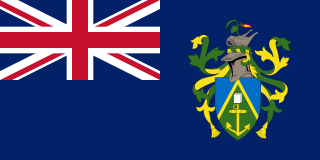The quintal is a historical unit of mass.
Contents
Quintal may also refer to:
The quintal is a historical unit of mass.
Quintal may also refer to:

The Pitcairn Islands, officially Pitcairn, Henderson, Ducie and Oeno Islands, are a group of four volcanic islands in the southern Pacific Ocean that form the sole British Overseas Territory in the Pacific Ocean. The four islands—Pitcairn, Henderson, Ducie and Oeno—are scattered across several hundred miles of ocean and have a combined land area of about 18 square miles (47 km2). Henderson Island accounts for 86% of the land area, but only Pitcairn Island is inhabited. The inhabited islands nearest to the Pitcairn Islands are Mangareva, 688 km to the west, as well as Easter Island, 1,929 km to the east.
Saint Martin may refer to:

The history of the Pitcairn Islands begins with the colonization of the islands by Polynesians in the 11th century. Polynesian people established a culture that flourished for four centuries and then vanished. They lived on Pitcairn and Henderson Islands, and on Mangareva Island 540 kilometres (340 mi) to the northwest, for about 400 years.
Saunders is a surname of English and Scottish origin, derived from Sander, a mediaeval form of Alexander.
George Hunn Nobbs baptised George Hunn was an English missionary on Pitcairn Island and later Norfolk Island, where many of his descendants still live today.
Arthur Quintal may refer to:
Adams is a common surname of English and Scottish origin, derived from the given name Adam. Related surnames include Addams and McAdam/MacAdam.
Arthur Young may refer to:

The descendants of the Bounty mutineers include the modern-day Pitcairn Islanders as well as a little less than half of the population of Norfolk Island. Their common ancestors were the nine surviving mutineers from the mutiny on HMS Bounty which occurred in the south Pacific Ocean in 1789. Their descendants also live in New Zealand, Australia, and the United States.
Alexander Robertson may refer to:
Vallières may refer to:
Savoie is a French department in the Auvergne-Rhône-Alpes region of the French Alps.
Edward Quintal was the first magistrate of the British Overseas Territory of Pitcairn Island.

Arthur Quintal was a Pitcairn Islander who served as the island's second magistrate from 1840 to 1841. Quintal was the son of Matthew Quintal, the bounty mutineer, and his wife Tevarua. The elder Quintal was killed with a hatchet in 1799. Arthur appears to have inherited some of his father's bad temper; he allegedly treated his sister Jane 'so harshly' she left the island and never returned. Quintal also allegedly made a pact with his best friend Daniel McCoy, to take each other's sister as a wife. Quintal married Catherine McCoy, and they had 9 children, including Arthur Quintal II, who also became magistrate. After Catherine's death in 1831, Arthur married Mary Christian and had a further 5 children. He succeeded his half brother as magistrate, and was succeeded by his brother-in-law. Quintal died on Norfolk Island in 1873.
Arthur Quintal, Jr. served as Magistrate of the Overseas British Territory of Pitcairn Island on three occasions between 1845 and 1854, he served as Magistrate of Norfolk Island twice between 1862 and 1885. Quintal was the son of Arthur Quintal, Sr. and Catherine McCoy. He was a grandson of Matthew Quintal and William McCoy. Quintal was known as Dowley. Quintal married Martha Quintal, his half-cousin, who was the daughter of Edward Quintal, Arthur Sr's half-brother. They had 11 children, Quintal died on Norfolk Island in 1902.
Tessy may refer to:

Christian is an English surname from the Latin "Christianus" meaning follower of Christ, from "christus" ("anointed"), created to translate the Hebrew messiah. As one of the native Manx surnames the name originates as an anglicisation of "Mac Christen"; Notable people with the surname include:

The complement of HMS Bounty, the Royal Navy ship on which a historic mutiny occurred in the south Pacific on 28 April 1789, comprised 46 men on its departure from England in December 1787 and 44 at the time of the mutiny, including her commander Lieutenant William Bligh. All but two of those aboard were Royal Navy personnel; the exceptions were two civilian botanists engaged to supervise the breadfruit plants Bounty was tasked to take from Tahiti to the West Indies. Of the 44 aboard at the time of the mutiny, 19 were set adrift in the ship's launch, while 25, a mixture of mutineers and detainees, remained on board under Fletcher Christian. Bligh led his loyalists 3,500 nautical miles to safety in the open boat, and ultimately back to England. The mutineers divided—most settled on Tahiti, where they were captured by HMS Pandora in 1791 and returned to England for trial, while Christian and eight others evaded discovery on Pitcairn Island.
Arthur Herbert Young was a Pitcairn Islander. He served as Chief Magistrate of Pitcairn in four spells between 1907 and 1941.
Teio, also known as Te'o, Mary, and Sore Mummy, was a Tahitian woman who settled on Pitcairn Island with the Bounty mutineers. Alongside Mauatua and Teraura, she is one of the island's six original matriarchs.